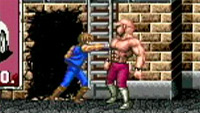No complaints here: Double Dragon Advance
 I’ve finally managed to put some time in with Double Dragon Advance, after finding myself impressed with it on release and tracking it down two years later. I do believe I’ve found in it one of my favorite beat ’em ups ever, and a game that remedies most of the problems common in its genre.
I’ve finally managed to put some time in with Double Dragon Advance, after finding myself impressed with it on release and tracking it down two years later. I do believe I’ve found in it one of my favorite beat ’em ups ever, and a game that remedies most of the problems common in its genre.
The bulk of my experience with the Double Dragon series was with the PC port of Double Dragon II. That version of the game was not without its problems, especially on an XT-class 8088, but I still had a lot of fun in its two-player mode with my dad. When I saw the iron-masked first-stage boss from DD2 in DDA, my nostalgia overtook me and I knew I had to give it a try.
The first thing about the game that caught my eye was the way enemies can be stunned and then dealt with in a variety of ways. Two punches, a kick, or a weapon attack will cause an enemy to momentarily freeze in a hunched-over pose. The player can then execute one of a few specific attacks, like a throw, a grab and hit, or a special kick. This sort of freedom from the usual 3-hit combo isn’t something I’ve seen too often in the genre (if at all), so I thought it might have been a new addition to the series. However, when I went back and tried the original arcade DD, I noticed that there’s a similar mechanic at work. The stun window isn’t nearly as big, and it’s not as visible, but it works similarly in practice. Of course, the original doesn’t allow for nearly as many attack options, nor is it as easy to consistently carry off the moves you want.
Where DDA really shines is in its variety of moves and its polished fighting mechanics. It integrates all the moves you could do in DD1 and 2, along with new moves, like an uppercut and a kick you can do from a crouch, and a dash that you can punch or kick from. You can also now hit enemies while they’re on the cround. You can straddle an enemy’s chest and punch him repeatedly, UFC-style, or do a Virtua Fighter-style flying stomp attack. All the moves feel well-tuned and are fun to use, and mastery of them is what the game seems to be all about. I’m not too hot at the game yet (I can barely make the second or third stage on a credit), but I would imagine that a one-credit clear would involve proper crowd management and use of moves in favor of memorizing enemy positions (Final Fight-style). This game feels like it’s meant to be mastered and one-credited, not like something that’s meant to simply take your money.
The game’s structure takes levels from DD1, redrawn and recolored, and throws in levels that I believe are from Super Double Dragon. Enemies from both DD1 and DD2 are present here, as well as music from both games. All of the sprites have been redrawn and are better-animated now, and little things like movement speed and frame timing and how a kick or punch feel are better-tuned here than in any previous DD game. There’s none of the series’ frequent slowdown here. Billy and Jimmy now resemble Bruce Lee more than ever, and have several new animations in which they affect Lee-style poses. I get the feeling that the original creators took a second look at their early efforts and decided to re-tune the whole package with an additional fifteen-plus years of experience behind them. They knew well enough to improve what they had by including only elements that would complement their existing foundation. Some of the reviews I’ve read criticized the game a bit for not including concessions to more modern design (like unlockables, maybe?), but I found this refreshing. This is how remakes should be done.